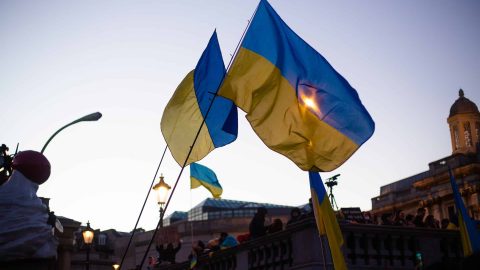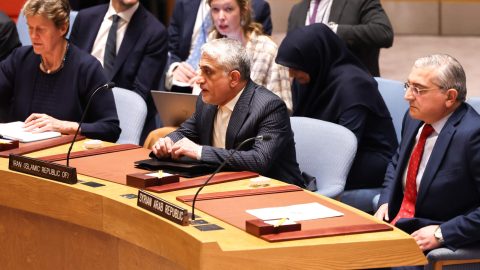One year after the start of the Russian war of aggression on Ukraine, the economic impact is felt around the globe. Particularly the rapid rise in energy prices after the start of the war has been internationally reflected in high inflation rates and counteracting interest rate hikes.
The price of Brent crude, the benchmark oil grade, intermittently rose from around USD 80 per barrel (159 liters) in early 2022 to over USD 130 shortly after the start of the war. The oil embargo against Russia, which has since come into force, also fueled concerns about inadequate oil supplies. Since then, the situation on the oil market has eased again, with Brent recently trading at around 83 dollars per barrel. Gas prices also rose sharply, stoking fears of supply bottlenecks in Europe – especially as a significant proportion of natural gas is supplied by Russia.
The energy crisis weighed heavily on many Western European economies, among them Germany. The Kiel Institute for the World Economy (IfW) noted in December that compared with economic expectations before Russia’s invasion of Ukraine, German economic performance would decline by EUR 180bn in 2022 and 2023 alone, being 4 per cent lower “at the end of this period,” according to the IfW.
Inflation Rates Easing off Slightly After Skyrocketing
The energy price shock as well as the corresponding food price increases had a massive impact on consumer prices. Inflation in the eurozone has been on an unprecedented upward spiral since the introduction of the euro, climbing from 1.9 per cent in June 2021 to 10.6 per cent in October 2022, before easing off a little to 8.5 per cent in January 2023. In Germany, inflation rose to an average of 7.9 percent in 2022 – the highest level since the founding of the Federal Republic. Here too, however, there were signs of an easing towards the close of the year.
In the meantime, central banks have been fighting the high inflation rates with several interest rate increases. In February, the ECB raised its key interest rate by another .5 percentage points to 3.0 per cent, marking the fifth consecutive rate hike. According to an ECB study, the massive surge in inflation in theeuro zone will also have an impact on government finances in the medium term. In view of the strong interest rate hikes in response to the surge in inflation, governments will have to prepare themselves for rising refinancing costs, while at the same time possibly having to face higher expenditures because of the weak economy, the ECB warns.
The stock markets have meanwhile coped with the fears of the Ukraine war’s economic consequences. After sharp losses immediately following the start of the war and a stock market year plagued by fears of inflation and interest rates, many markets have recovered to pre-war levels. The Euro-Stoxx-50, for example, is already up almost 13 per cent since the start of the year, following a drop of around 11 per cent last year.
Ukraine Hoping for a Quick new Start After Devastating Economic Collapse
Naturally, the economic damage in Ukraine itself is devastating. In a study published at the end of January, the Kyiv School of Economics estimates the direct material damage at a total of USD 138bn. Of this, 54 billion was incurred by the destruction or damage of 149,000 residential buildings, around 36 billion by destruction or damage of public infrastructure and 13 billion by destruction or damage of business assets since the start of the war.
Ukraine’s economy has shrunk more since February 2022 than at any time since its independence in 1991. According to an official estimate, gross domestic product fell even more sharply than expected, by 30.4 per cent. The agricultural sector, which is important for Ukraine, has suffered greatly. The metal industry, which is important for the country, has also suffered a massive loss of production capacity with the destruction of the steelworks in the port city of Mariupol. In addition, the steel sector is also suffering from the fact that Russia is blocking the seaports that are important for Ukraine’s exports.
The country’s credit ratings suffered greatly from the war of aggression raging in it. Rating agency Moody’s recently lowered its credit rating for Ukraine to the “Ca” level, placing the Ukraine on the brink of default.
The Ukrainian government hopes for a rapid economic recovery after the end of the war and has already drawn up a reconstruction plan. This “National Recovery Plan” assumes a cost of USD 750bn, two-thirds of which is to be supplied by foreign donors. With the help of this investment and a reduction in taxes and duties, the Ukrainian economy is expected to take off and increase its GDP fivefold from nearly USD 100bn in 2022 to USD 500bn in 2032. The country is also hoping for a quick new start following its eagerly awaited accession to the EU in the near future.
A joint study conducted by the Vienna Institute for International Economic Studies (wiiw) and the GROWFORD Institute in Kiev sees these plans as unrealistic, but attests to Ukraine’s generally strong growth potential. The study assumes that the most intensive phase of the war will last until mid-2023.
According to the study, international donors would have to contribute about USD 410bn to reconstruction. “The EU, which has a powerful self-interest in a democratic and prosperous Ukraine and which has also made it a candidate country, will have to hugely step up its efforts there,” said wiiw co-author and deputy director Richard Grieveson. The study also recommends using the economy’s new start for structural change.
Instead of heavy industry and agribusiness, Ukraine should rather invest in IT and environmental technologies, two sectors for which the study authors see great potential in Ukraine.
Russia Coping With Sanctions Better Than Expected
Russia’s economy is also suffering from the war, particularly from the severe sanctions imposed on the country by Western countries. According to EBRD Chief Economist Beata Javorcik, those industries that rely on imported primary products are suffering the most. However, the sharp economic slump initially expected as a result of the sanctions has so far failed to materialize. Experts expect the sanctions to take some time yet to take full effect.
In the first year of the war, 2022, Russia’s gross domestic product shrank by 2.2 per cent, where some experts expected a slump of at least 10 per cent due to the Western sanctions. According to the central bank, however, the domestic economy, which has had to live with sanctions for years, has quickly adapted to the new situation. The International Monetary Fund (IMF) predicts a mini-growth of 0.3 per cent for this year and a plus of 2.1 percent for 2024.
Russia’s inflation rate averaged 11.9 per cent last year, almost three times higher than the central bank’s target of 4 per cent. The official unemployment rate was at a record low of 3.7 per cent in December. One likely contributing factor is that hundreds of thousands of Russian men of working age have fled the country since the war began to avoid conscription. High-ranking government and central bank officials have already expressed concern about the labour market.
For a glossary of technical terms, please visit this link: Fund Glossary | Erste Asset Management
Legal note:
Prognoses are no reliable indicator for future performance.
Legal disclaimer
This document is an advertisement. Unless indicated otherwise, source: Erste Asset Management GmbH. The language of communication of the sales offices is German and the languages of communication of the Management Company also include English.
The prospectus for UCITS funds (including any amendments) is prepared and published in accordance with the provisions of the InvFG 2011 as amended. Information for Investors pursuant to § 21 AIFMG is prepared for the alternative investment funds (AIF) administered by Erste Asset Management GmbH pursuant to the provisions of the AIFMG in conjunction with the InvFG 2011.
The currently valid versions of the prospectus, the Information for Investors pursuant to § 21 AIFMG, and the key information document can be found on the website www.erste-am.com under “Mandatory publications” and can be obtained free of charge by interested investors at the offices of the Management Company and at the offices of the depositary bank. The exact date of the most recent publication of the prospectus, the languages in which the fund prospectus or the Information for Investors pursuant to Art 21 AIFMG and the key information document are available, and any other locations where the documents can be obtained are indicated on the website www.erste-am.com. A summary of the investor rights is available in German and English on the website www.erste-am.com/investor-rights and can also be obtained from the Management Company.
The Management Company can decide to suspend the provisions it has taken for the sale of unit certificates in other countries in accordance with the regulatory requirements.
Note: You are about to purchase a product that may be difficult to understand. We recommend that you read the indicated fund documents before making an investment decision. In addition to the locations listed above, you can obtain these documents free of charge at the offices of the referring Sparkassen bank and the offices of Erste Bank der oesterreichischen Sparkassen AG. You can also access these documents electronically at www.erste-am.com.
Our analyses and conclusions are general in nature and do not take into account the individual characteristics of our investors in terms of earnings, taxation, experience and knowledge, investment objective, financial position, capacity for loss, and risk tolerance. Past performance is not a reliable indicator of the future performance of a fund.
Please note: Investments in securities entail risks in addition to the opportunities presented here. The value of units and their earnings can rise and fall. Changes in exchange rates can also have a positive or negative effect on the value of an investment. For this reason, you may receive less than your originally invested amount when you redeem your units. Persons who are interested in purchasing units in investment funds are advised to read the current fund prospectus(es) and the Information for Investors pursuant to § 21 AIFMG, especially the risk notices they contain, before making an investment decision. If the fund currency is different than the investor’s home currency, changes in the relevant exchange rate can positively or negatively influence the value of the investment and the amount of the costs associated with the fund in the home currency.
We are not permitted to directly or indirectly offer, sell, transfer, or deliver this financial product to natural or legal persons whose place of residence or domicile is located in a country where this is legally prohibited. In this case, we may not provide any product information, either.
Please consult the corresponding information in the fund prospectus and the Information for Investors pursuant to § 21 AIFMG for restrictions on the sale of the fund to American or Russian citizens.
It is expressly noted that this communication does not provide any investment recommendations, but only expresses our current market assessment. Thus, this communication is not a substitute for investment advice.
This document does not represent a sales activity of the Management Company and therefore may not be construed as an offer for the purchase or sale of financial or investment instruments.
Erste Asset Management GmbH is affiliated with the Erste Bank and austrian Sparkassen banks.
Please also read the “Information about us and our securities services” published by your bank.



